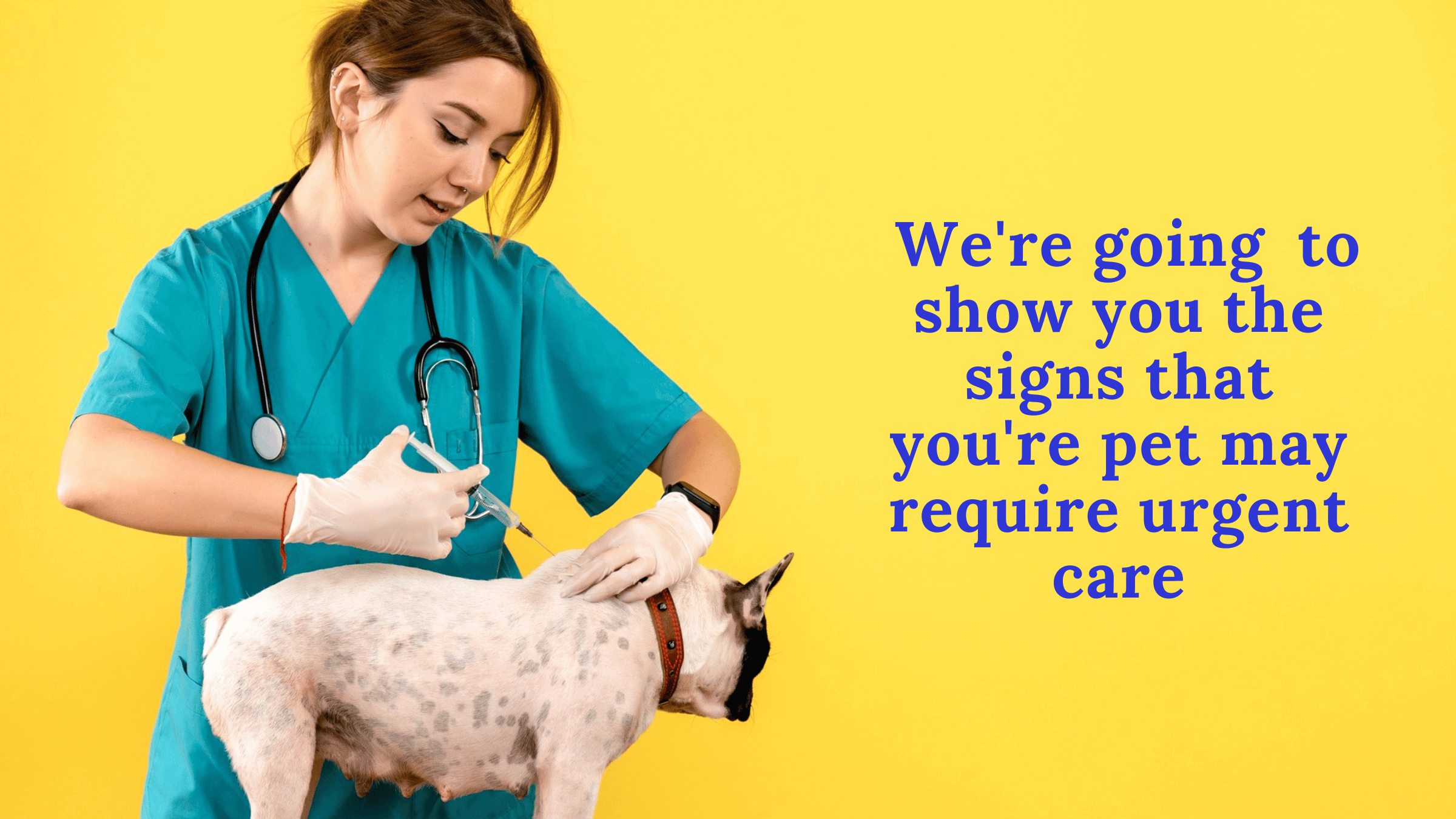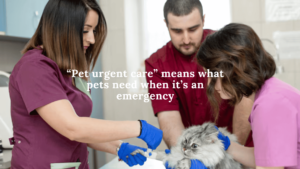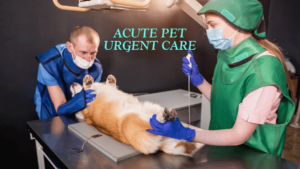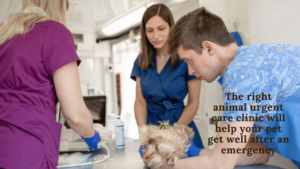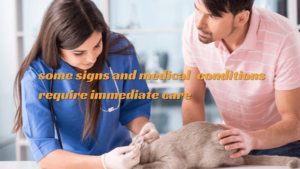For our four-legged friends, “pet urgent care” can be a godsend during a crisis. For every pet parent, knowing when you should look for emergency veterinarian services is critical because being able to act fast could save your pet’s life.
From a sudden injury, poisoning, severe allergic reaction, “pet urgent care” is what ensures that excellent, needed care is administered the moment they arrive.
In this guide, we’re going to show you the signs that you’re pet may require urgent care, tips for handling emergencies, and how to find the right pet emergency vet to help keep your furry family member safe and healthy.
Understanding Pet Urgent Care
“Pet urgent care” means what pets need when it’s an emergency and can’t wait for a regular trip to the vet. Regular check-ups are vital in helping maintain your pet’s overall health, whereas urgent care helps tackle more immediate and life-threatening issues that require fast action.
Unlike routine vet checkups, which are usually planned in advance for vaccinations, wellness exams or ongoing treatments, “pet urgent care” is built around acute conditions that can deteriorate swiftly without appropriate medical care.
Common scenarios for pet urgent care include: major injury, shortness of breath, poisoning, seizures, whereby your pet has suddenly changed their behavior to the extent of indicating that something isn’t right.
When you have a pet, being a vertex that leads to “emergency pet care” can literally reduce the chance of loss in case your dog eats something poisonous. Similarly, if a cat looks as though it has suddenly stopped breathing, or if it is wildly vomiting, these are red flags that merit evaluation immediately at an “animal urgent care clinic.”
The difference between routine care and “acute pet urgent care” is in the urgency of treatment, she added. Routine vet visits tend to be more about prevention, while urgent care is focused on life-threatening emergencies.
In many instances, “pet urgent care” clinics are equipped with advanced diagnostic tools and treatments accessible around the clock, offering services that your regular vet may not be able to provide outside office hours. These “pet emergency services” fill a gap in moments of urgency.
It is also useful to be familiar with “pet first aid” before heading to an animal urgent care clinic. Familiarizing yourself with how to stabilize your pet or control bleeding until professional help arrives can make all the difference in an emergency. Knowing when a condition requires urgent care — and how to manage the situation — can help minimize stress in a crisis.
Now, while pet urgent care is critical, you need to understand about pet urgent care cost. Emergency vet visits are generally more costly than regular appointments because they require advanced equipment and immediate attention. Still, the expense is often warranted by the need and the lifesaving treatment rendered.
To offset costs, some pet owners invest in pet insurance, or build emergency savings, both of which can prove vital in a crunch.
Signs Your Pet Needs Emergency Pet Care
Learning to identify when your pet needs “emergency pet care” can enhance their chances of survival, and how quickly they recover. Emergencies call for immediate attention, unlike regular check-ups or minor health problems.
“Pet urgent care” clinics are qualified to treat life-threatening conditions — but as a pet owner, it’s up to you to know when to find them. Here we’ll cover some of the common symptoms that indicate your pet needs urgent care and how you can quickly determine your fur baby’s condition.
Severe Bleeding — One of the clearest indicators that you need to bring your pet in for emergency pet care is severe bleeding. Trazodone can be taken in an emergency, or whenever you need it to combat insomnia.
If you are noticing your pet bleeding a lot, you should put pressure on the wound and go directly to an “animal urgent care clinic.” Internal bleeding might result in pale gums, weakness and vomiting. Knowledge of “pet first aid” is critical here because it helps stabilize your fur kid until you get to the clinic.
Difficulty breathing is another serious condition calling for “pet urgent care.” And if your pet is having difficulty breathing, either very rapidly or with loud, labored breaths, he or she may have a serious problem such as a blocked airway, heart failure or asthma.
Breathing difficulty is a clear sign that the pet requires immediate emergency pet care. Look for other signs, such as blue or pale gums, which might indicate that the patient doesn’t have enough oxygen. In this scenario, staying calm and getting your pet to a facility with “pet emergency services” should be your top priority.
Another very concerning sign that warrants the immediate need for “pet urgent care” is when your pet suffers a seizure. If your pet has a seizure, you might see them shake, drool or lose consciousness. Seizures can stem from any number of problems, including toxins, infections, or neurological issues.
If you can safely wait until the end of a seizure, but it’s a brief one, it is still best to call an emergency vet as soon as possible. In the meantime, place any objects that could injure your pet out of reach and do not try to hold your pet still during a seizure. If the episode is over, take your pet to an animal urgent care clinic to be checked out.
In addition to this array of common emergency signs, there may be other less overt symptoms that mean your pet is in trouble. If your pet has persistent vomiting or diarrhea, again this could be a sign of poisoning or a gastrointestinal problem that requires “acute pet urgent care.”
In the same vein, if your pet seems to suddenly lack energy, or is there but not responding, that could indicate serious conditions like a heart attack or a stroke.
To assess your pet’s condition quickly, focus on the following:
- Breathing rate: Is it fast or labored?
- Gum color: Are they pale, blue, or red?
- Mobility: Is your pet able to walk, or are they stumbling or paralyzed?
- Behavior changes: Are they unusually aggressive, disoriented, or excessively sleepy?
If any of these symptoms are present, it’s important to listen to your instincts and seek “pet urgent care” right away. Even when in doubt, it’s always better safe than sorry when it comes to the health of your pet.
Be aware of “pet urgent care cost,” too, as financial concerns may prevent some pet owners from seeking care. Many of these animal urgent care clinics will have payment plans, and/or accept pet insurance that can lower the costs of an emergency.
Understanding this will give you some peace of mind so you can concentrate on what’s most important — the health and well-being of your pet.
Acute Pet Urgent Care: What to Do Before You Reach the Vet
In an emergency, time is of the essence, and “pet urgent care” can mean the difference between life and death. Knowing what to do before you get to an “animal urgent care clinic” can help stabilize your furbaby and keep conditions from worsening.
A quick introductory guide to emergency aid for pets, which items are most vital to your “pet first aid” box, and advice on how best to get your pet safely to the clinic for “acute pet urgent care“:
1. First Aid Guide for Pet Emergencies
In emergencies involving your pet, it’s important to act quickly. Here are some common instances that may call for “pet urgent care,” as well as first aid precautions:
Severe bleeding: If your pet is bleeding profusely, apply pressure to the wound with a clean cloth or bandage. If you can, raise the injured limb to decrease blood flow to the site. “Pet urgent care” usually means addressing an immediate problem, like bleeding, so take your pet to the vet without delay.
Choking or difficulty breathing: If your pet is choking, look in their throat for blockages and gently take them out. If your pet is having trouble breathing, calm them down and immediately take them to animal urgent care. Trouble breathing could indicate a life-threatening problem that needs “emergency pet care.”
Seizures: If your pet has a seizure, clear objects out of their way, but don’t try to restrain them. Timestamps the length of the seizure, as longer seizures demand more rapid intervention. Then, wrap your pet in a soft blanket and go directly to an animal urgent care clinic for evaluation.
2. Essential Items for Your Pet First Aid Kit
Be prepared for emergencies to be ready to spring into action in crisis, keep an emergency pet first aid kit stocked with the following items:
Sterile gauze and bandages: To wrap wounds and control bleeding until you can get your pet to a vet..
Tweezers: great in case you have to remove a splinter or tick that’s bothering your pooch.
Antiseptic wipes: For cleaning any cuts or scrapes to keep infection away
Thermometer: Used to check for fever or abnormal bodily temperature in situations of infection or illness.
Muzzle: If your pet is hurt or scared, you may want to use a muzzle on them so they don’t bite anyone, but only if you need to.
Having these items at your fingertips allows you to administer immediate care while making your way to pet urgent care.
3. How to Safely Transport Your Pet
After giving basic first aid, your next step is here to get your pet to an animal urgent care clinic safely. Here are the best practices to ensure your pet is as comfortable and safe as possible during transportation:
Use a carrier or crate: If your pet is small enough, a carrier will keep them safe and help reduce stress. For bigger pets, gently carry them with a blanket or towel to reduce risk of further injury.
Stabilize your pet: If your pet is injured, or in pain, try to keep your pet still in transport. You want to support their neck and spine to avoid further injury.
Call ahead: If you can, call the animal urgent care clinic before you go to let them know you’re on your way. This aids the staff in preparation and may expedite treatment once you reach the place..
Preparation and calmness are key, so when it comes to “pet urgent care“… Knowing how to keep your pet stable and having a plan will ensure that they receive the best possible care in a timely fashion.
Because acute pet urgent care requires quick action, plan ahead and do not hesitate to call for professional assistance when necessary.
Pet Urgent Care Cost: What to Expect
That is one reason why understanding “pet urgent care” costs is important for pet owners. Emergency vet care in a crisis can be shocking, but if you know what to anticipate you can plan ahead and make the best decisions possible.
In this section, we’ll go over the average cost of emergency pet care, the different factors that contribute to pricing, and we’ll provide some tips regarding how to prepare for an emergency financially.
1. Typical Costs of Emergency Pet Care
The price of this “pet urgent care” will differ depending on the clinic, your pet’s ailment, and what kind of treatment it may need. But in an emergency, you’ll typically need to pay for some key services:
Consult Fees: Most animal urgent care clinics will charge a consult fee for evaluating your pet. This cost typically runs between $50-$150 depending on the clinic and location.
Diagnostic Tests: Diagnostic tests, such as blood work, X-rays or ultrasounds, are often required to determine the cause of your pet’s symptoms. Depending on the complexity of the tests, these can range from $100 to $500 or more.
Treatment Costs: If your pet needs urgent care, like suturing a wound or receiving oxygen therapy or IV fluids, it can be anywhere from $100 up to $1,000 or more, depending on how serious the problem is.
Medications: If you’re given any medication during an emergency (pain medications, antibiotics, etc), add another $20 to $100 to the total bill, depending on the type and amount.
Besides these essential services, your costs can go up considerably if your pet needs surgery or overnight monitoring. An emergency surgery, for instance, could cost anywhere from $500 to $3,000, depending on how involved the procedure is.
2. Factors That Influence the Cost of Pet Urgent Care
There are many things that can influence the total price of “pet urgent care”, including:
Severity of Injury or Illness: More serious illnesses, such as trauma, poisoning or life-threatening conditions, often necessitate more intensive treatment, which may increase the cost. The more immediate and complicated the treatment required, the steeper the price.
Location of the Clinic: The price of an animal urgent care clinic depends on its location. Clinics based in larger cities or wealthier neighborhoods might have higher fees than those in rural or less populated areas. Moreover, 24/7 emergency clinics are likely to be more expensive because of their 24-hour service availability.
Expensive Booking Hours: Using emergency services after hours, over the weekend, or on holidays may also be more pricier given the extra convenience and availability. If you’re seeking out an emergency clinic after regular office hours, you’ll likely pay top dollar.
3. How to Financially Prepare for Pet Urgent Care
Having a plan for how to financially prepare for “pet urgent care” can ease stress in an emergency. Here are some ways to deal with the costs of “emergency pet care”:
Pet Insurance: Having pet insurance is one of the best ways to prepare for a potential pet emergency. Depending on their plan, many pet insurance policies will cover all or most emergency expenses, from consultations and treatments to medications and surgery. Explore and compare plans, selecting one that aligns with your budget and coverage requirements..
Emergency Savings Fund: The alternative is an emergency savings fund to cover pet crises. Put a little away each month, so you’re financially prepared if your pet requires acute pet urgent care.
Payment Plans and Financing: Many clinics will allow you to set up a payment plan or they may offer to finance your vet bill. When you arrive at the clinic, ask about these options or call ahead to make sure that it has payment assistance programs.
Care Credit: Some clinics accept Care Credit, a healthcare credit card explicitly for veterinary expenses. This may be a useful option if you require care immediately but do not have the funds available.
While “pet urgent care” costs can be high, being preemptive and proactive about your pet’s health can help alleviate some of the financial wear and tear.
The right insurance, savings plan, or payment options can ensure your co-pilot gets the care they need, and most importantly, you can make decisions about their health based on what is best for their well-being, devoid of concerns that these apropos treatments may come at an extravagant price.
Choosing the Right Animal Urgent Care Clinics
The right animal urgent care clinic will help your pet get well after an emergency. Considering there are so many options, figuring out which clinics are worth checking out based on things like facility quality, “pet urgent care” services and availability is crucial.
In this segment, we’ll provide some tips on how to locate your local, trusted animal urgent care clinics, as well as key points to keep in mind when deciding which is best for your pet’s needs.
1. How to Find Reliable, Trusted Animal Urgent Care Clinics Nearby
Researching and asking the right questions about an animal urgent care clinic will help you in finding one that is reputable. Here are some tips for making sure you’re choosing a good clinic:
Seeking Recommendations: Getting a recommendation from your regular vet, local pet owners, or even online pet community is one of the best ways to search for a good and reliable clinic. Your trusted vet may have referrals or relationships with local emergency clinics.
Check Online Reviews: Online reviews and testimonials can give you important information about the quality of the clinic. Sites like Google Reviews, Yelp, or specialized veterinary review sites can give you a feel for the experiences of other pet owners. Read reviews, too, to find clinics that are highly rated, have a quick service and a decent emergency feedback.
Accreditation Check: One way to research a veterinarian is to check their accreditation by the American Animal Hospital Association with the AAHA. This means that the clinic has met high standards of care, ensuring that your pet is in good hands. Also, find out if the clinic is affiliated or certified.
2. Factors to Consider When Choosing an Animal Urgent Care Clinic
When selecting a clinic for pet urgent care, there are several factors to keep in mind to ensure your pet gets the best care possible:
24/7 Access: Emergencies can strike at any hour: you need to be able to access care 24-7. Make sure the clinic you select can provide emergency pet care services round the clock, even on weekends and holidays. Some animal urgent care clinics can have limited hours, so it’s important to double-check that they’ll be there for you when you need them the most.
Cleanliness and Quality of the Facility: A clean, well-kept facility shows you that they take care of their pets and will take good care of yours as well.
Try to visit the clinic — if not possible, search the web for pictures and detailed descriptions of its facilities. Seek a clinic which has modern diagnostic equipment, is in a clean and welcoming environment and works with trained personnel capable of tackling any emergency.
Proximity: When you have a pet emergency, you need to be able to reach the clinic fast. While the location of the animal urgent care clinic is very important, you want to make sure you’re not wasting precious time driving.
Choose a clinic that’s reasonably close to your home. This makes sure you can reach them quickly in an emotional emergency.
Specialization: A few “urgent pet centers” provide specialized treatment, operations, or advanced imaging (X-rays, ultrasounds, etc.), or have specialists in various disciplines (such as cardiology and neurology).
If your pet has a chronic condition, it’s worthwhile to locate a clinic that can give your pet the specialized care he or she may require in the event of an emergency.
3. Additional Tips for Choosing the Right Clinic
Call Ahead: If you’re able, call the clinic in advance to ask about the services it provides, its prices and what to expect in an emergency situation. This will give you a feel for how well they communicate and if they’re responsive to urgent matters.
Understand the clinic’s emergency protocol: Confirm that there is a clear emergency protocol in place. That’s not just about the initial care your pet will receive but also follow up care, medication management and guidance on any home care that may be necessary.
Costs and Payment Options: While “pet urgent care” can be pricy, you’ll want to make sure any clinic provides clear, transparent pricing and will accept payment methods or financing options that fit within your budget. Some clinics also offer payment plans, or might even accept pet insurance, which can help ease the financial burden in an emergency.
Considering these factors will ensure the animal urgent care clinic you choose can provide the best care for your pet in an emergency.
Forget the phrase “pet urgent care” — that’s not just something you do when you need to solve a problem right away, that is making sure your pet gets the best possible care when they need it.
Pet Urgent Care Tips for Pet Owners
The best way to keep your pet healthy and safe is to prevent emergencies before they happen. Although some circumstances are unavoidable, there are measures you can take as an animal parent to help with the odds of not needing “pet urgent care” at all.
Here, we’ll share some actionable pet urgent care tips you can use to help keep your pet in tip-top shape, and how to prepare for a possible emergency.
1. Regular Check-Ups and Health Monitoring
Regular veterinary visits are vital to preventing many health problems that could be an emergency. Regular veterinary care allows your vet to catch early signs of disease so they can be treated before they become very serious. I have some regular health monitoring tips for pet urgent care:
Schedule Yearly Check-ups: Take your pet in for a complete physical thankfully at least one time every year. Regular veterinary visits do help ensure that your pet is up to date on vaccinations, flea/tick treatments and preventive care, such as dental health checks.
Keep Track of Weight and Nutrition: Monitoring your dog’s weight and nutrition is essential in avoiding problems like obesity (which can cause heart disease, joint pain, and much more)! Create/monitor their eating habits regularly and talk to your vet to get the best diet chart plan.
Monitor Changes in Behavior: Changes in your pet’s behavior — such as lethargy, aggression, or an abrupt lack of appetite — can be a sign that a health issue is developing. However, if you observe any unusual behavior, consult your vet as soon as possible to avoid an emergency scenario.
2. Vaccinations and Preventive Care
You should keep your pet’s vaccinations up to date, as many life-threatening diseases can be prevented in this way — no acute pet urgent care needed. (Other vaccines can protect against parvovirus, rabies, distemper, and others.) Routine vaccination helps protect your pet against serious diseases, as well as preventing the potential spread of infection to other animals.
Keep Vaccinations up to date: Continuing on vaccinations written on your vet’s chart (make sure that there are no missed vaccinations), your dog should have proper vaccinations, especially for puppies, and early vaccinations are required so that they can build immunity.
Parasite prevention: Fleas, ticks, or worms are frequent health threats for pets. Consistently using flea/tick preventatives and worming treatments will prevent many infections and other things that could lead to the need for “pet urgent care”.
Spaying/Neutering: This common procedure can decrease the incidence of certain types of cancers, decrease aggressive behavior, and help with overall health maintenance. Neuter or spay your pets one of the biggest emergencies a growing pet can face is owning a pet, but no, pun intended.
3. Create an Emergency Plan and Contact List
Though preventive measures are important, it is also crucial to be prepared for the unexpected. Having an emergency plan will help you act quickly and efficiently if an accident or sudden illness occurs. Here are some pet urgent care tips to prepare you:
Make an Emergency Vet Contact List: Write down numbers for the closest animal urgent care clinics and emergency animal hospitals that are open 24/7, as well as your regular vet’s number. You should be able to access this list easily, whether on your phone, in a wallet or hanging on a wall somewhere in your home.
Know Basic First Aid: If you’re in an emergency situation, knowing some basic first aid can go a long way. Learn how to treat common pet emergencies, such as stopping bleeding, performing CPR or how to deal with choking. Most veterinary clinics and online resources have classes or guides on basic pet first aid.
Keep Emergency Supplies on Hand: A well-stocked pet first aid kit is paramount, as we mentioned above. Be sure to pack essentials, such as bandages, antiseptic wipes, a thermometer, and any medications your furry friend may need during an emergency.
4. Keep a Health Record for Your Pet
It is crucial to keep track of your pets health history in case of “pet urgent care”, especially in case of an emergency. Keeps track of what vaccinations, treatments, surgeries, or medications your pet might have had, along with any rare health issues. And if your pet ever requires emergency care, a thorough health record can help your vet give quality treatment sooner.
Create a Pet Health File: This should include all information with regard to your pet’s history — their weight, allergies, previous injuries, surgeries and any chronic conditions of your pet.
Watch for Signs of Infection: Occasional assessment of your pet for signs of sickness–coughing, vomiting, diarrhea, skin or eye changes, etc. Catching these signs early can help avoid many scenarios that would lead to acute pet urgent care.
5. Be Aware of Pet Hazards Around the Home
Accidents often happen at home, but there are steps you can take to reduce the risk:
Pet-Proof Your Home: As a rule, keep dangerous chemicals, sharp things and small objects your pet might swallow off-limits. Just be mindful of plants that can be toxic to pets, such as lilies or ivy.
Be Cautious Due to Toxic Foods: Regular household foods (chocolate, grape and onion) may injure pet. Make sure to keep these items out of your pet’s reach, or in a location where everyone in the household knows they’re not pet safe.
Expertise helps us learn how to be proactive about protecting both our pet’s health as well as minimizing emergency situations. Routine care, health monitoring and preparedness are your best bets to prevent urgent situations, but having a plan will ensure that you’re ready if the unexpected occurs.
When to Seek Emergency Pet Care: A Quick Checklist
Well, knowing when to seek “pet urgent care” can be crucial to getting your pet timely help. Some cases can be managed at home, but some signs and medical conditions require immediate care from an animal urgent care clinic or emergency veterinarian.
Here we will outline the important signs that warrant urgent care, as well as a quick, accessible, printable list for pet owners to keep around in case a vet visit is needed.
1. Critical Signs That Demand Immediate Vet Attention
If your pet is showing any of the following symptoms, it’s time to get “pet urgent care” immediately. Here are some of the danger signs that indicate a serious condition that needs urgent intervention:
Heavy Bleeding: If your pet is bleeding heavily (and the blood won’t stop if you apply direct pressure), you need to seek emergency pet care right away. Uncontrolled bleeding can kill.
Difficulty Breathing or Choking: Having trouble breathing, any type of panting (especially if it is labored) or choking are all reasons to go to an animal urgent care clinic immediately. Problems with breathing may signal a blocked airway, asthma or heart failure — all conditions that require immediate attention.
Seizures: If your pet has a seizure lasting longer than 2 minutes, or has multiple seizures in a short period of time, this is a medical emergency. Immediate “pet urgent care” is needed to prevent additional brain or bodily damage.
Non-Responsiveness or Unconsciousness: If your pet collapses or becomes unresponsive, it is important to get to an emergency pet care facility immediately. This could be because of poisoning, a traumatic injury or other serious conditions.
Vomiting or Diarrhea (Severe or Prolonged): If vomiting or diarrhea persists, especially if there’s lethargy, dehydration may result, and urgent care may be needed. But these signs can sometimes indicate a serious illness that requires visiting an animal urgent care clinic.
Trauma or Injury: If your pet was injured in an accident, such as being hit by a car or falling from a height, you’ll want to get “pet urgent care” right away. Broken bones, deep cuts or internal injuries require prompt treatment to avoid complications.
Bloat or Distended Abdomen: In particular in large breed dogs, a bloat or distended abdomen can be a sign of gastric torsion, a life-threatening condition requiring urgent surgery. This is an obvious situation where you would need emergency pet care ASAP.
Ingestion of Poisonous Substances: If your pet has ingested something poisonous — like chocolate, plants or household chemicals: Call your vet or an animal urgent care clinic immediately. Early treatment can save your pet’s life.
2. Downloadable Emergency Pet Care Checklist
This checklist encompasses the indicators and other situations that warrant prompt care and can guide you through an emergency.
Emergency Pet Care Checklist:
- Severe Bleeding (Won’t stop with pressure)
- Choking or Difficulty Breathing
- Seizures (Lasting more than 2 minutes or recurrent)
- Unresponsiveness or Loss of Consciousness
- Vomiting/Diarrhea (Prolonged or severe)
- Trauma/Injury (Broken bones, deep cuts)
- Bloating or Abdominal Distention
- Limping/Unable to Walk
- Ingestion of Toxic Substances
3. Final Tips for Seeking Emergency Pet Care
Although having a checklist is useful, trusting your instincts as a pet owner is also a key component. If you have any doubt if your pet needs “pet urgent care” or not, it’s always better to go for it! Here are some other tips:
Call Ahead: Before you go to the animal urgent care clinic or emergency vet, call them and let them know you’re coming, if you can. This allows the staff time to prepare for your pet’s needs and accelerates things once you arrive there.
Be Calm: Relief situations are stressful and also staying calm will lead you to think clearly and perform accordingly. Utilize the pet urgent care checklist to determine how serious the problem seems and what information to have ready when you arrive.
Prepare What You Need to Know: Upon arriving at the clinic, know what to prepare because you’ll be asked for information about your pet’s symptoms, medical history, and any medications they might be on. This allows the vet to assess the situation quickly and decide on the best course of action.
Keeping this checklist and knowing the signs of a pet disaster will help you respond to any scenario more effectively. Prompt access to emergency pet care is crucial, and sometimes it can be difficult to know when to act, which can impact your pet’s health and well-being.
Conclusion
In the case of your beloved pet, “pet urgent care” is an important resource you need. When an emergency happens, responding quickly can mean the difference between long-term health complications for your pet or even saving your pet’s life.
Knowing when to seek emergency care for your pet, how to stabilize your animal before you get to the veterinary clinic, and being more proactive with preventive care are all important parts of your pet’s well-being.
We hope this guide gives you meaningful information and “pet urgent care tips” to help you feel more confident and prepared if a crisis arises. Make sure to keep yourself stocked with the phone number of your trusted animal urgent care clinic.
If you found this post helpful, share it with your fellow pet owners so they can prepare for the unexpected! Every pet owner should be familiar with the critical signs of when to seek “pet urgent care” and be prepared to act in an emergency.
Finally (if you haven’t already) you should probably make an appointment at a trusted veterinary emergency care clinic in your area. Of course, having a relationship with a knowledgeable clinic can add peace of mind, too, that you’re prepared for any emergency that could arise.
Be prepared, be calm, and always act fast when dealing with your pet’s health!
Frequently Asked Questions (FAQ)
1.What is the difference between regular vet visits and pet urgent care?
Regular vet visits are for standard checkups, vaccinations and preventative care, whereas “pet urgent care” is for emergencies that need to be handled right away. The treatment of serious conditions, including severe bleeding, breathing difficulties, trauma, or poisoning, that cannot wait for an appointment with your regular veterinarian. For more details, check out this article on the difference between routine vs. urgent vet care from American Kennel Club.
2.How do I know if my pet’s condition is an emergency?
If your pet is showing severe symptoms such as uncontrolled bleeding, difficulty in breathing, experiencing seizures, or loss of consciousness, you must seek emergency pet care immediately.
Included in our guide above is a checklist of critical signs that need immediate attention, and can help you in determining if your pet needs “pet urgent care.” For additional insight, see this emergency checklist from the Veterinary Emergency Group.
3.Is pet urgent care expensive?
The cost of pet urgent care can vary widely depending on factors like the severity of the condition, the location of the clinic, and type of treatment required.
Whether through pet insurance, savings, or knowing the average price of pet urgent care for your neck of the woods, it’s essential to be financially prepared for the unexpected. Learn more about the cost of emergency pet care in this article from PetMD.
4.Can I perform first aid on my pet before reaching an animal urgent care clinic?
Yes, administering basic first aid can stabilize your pet and limit further injury until you get to the clinic. It is crucial to remain calm and follow steps for common emergencies, such as how to stop bleeding or perform CPR. Make sure to have a pet first aid kit for these circumstances. Check out this first aid guide from the American Red Cross.
5.Should I call an animal urgent care clinic before bringing my pet in for treatment?
If you’re able, it’s always best to call ahead. This gives the clinic time to ready themselves for your pet’s arrival and makes sure they have the resources available to treat your pet efficiently. It can also help cut down on wait times once you get there. For more tips, visit the Petfinder website on finding the right emergency vet.
6.How can I prevent my pet from needing urgent care in the first place?
Preventive care is key! Routine care — check-ups, vaccinations, parasite prevention and health monitoring — can identify problems before they become life-threatening emergencies.
Also, being familiar with what common pet dangers lie in or around your home, and keeping emergency numbers at your fingertips, will help you avoid ever having to seek urgent care in the first place.. Explore preventive care options at Banfield Pet Hospital.
7.Can I take my pet to any animal urgent care clinic?
Not all urgent care clinics around the country are created equal, so look into what’s available in your area; most animal urgent care clinics are only providing emergency care. Think about their hours, their proximity, consider how close they are, and the services that they are providing, what reputation do they have.
And their number varies according to the type of clinic (some clinics specialize more in specific care); therefore, it is important to find the ideal one for your pet. Check out this guide to finding the right emergency care provider from The Humane Society.

